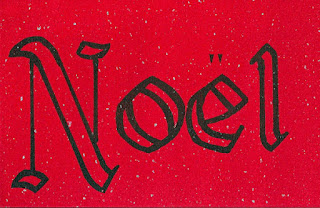It's been years since I've sent out Christmas cards en masse, though in the last couple of years I've sent out Valentines to folks who sent us holiday greetings. I'll probably do that again come February, though at last count, Tom and I had only received about five cards in the mail. I've received several holiday e-cards from people who used to send "real" cards, but in general, the custom of sending these obligatory annual missives seems to be dying a slow death.
That's fine with me, for the most part, since they seem like an added duty at a time of year that's busy and stressful enough. But looking at the handful of cards we received, I also remembered how much I loved retrieving December's mail from the box when I was a kid, looking at all the different kinds of handwriting, the postmarks from places that seemed far away and exotic to me at the time. It was a real treat when my parents let me open them, and even when I didn't get to open them myself, I enjoyed reading them.
In some ways, they were like condensed history lessons about my parents' pasts: where they'd lived, what they'd done, who they'd been long before I was born. There were many old friends of my parents who I only knew through their cards, like my dad's college friend Jim Dukas, who was a professional actor in New York City. His cards were always the funniest ones, and I remember his distinctive, slanty writing that was sort of halfway between print and cursive. I actually met him during a high-school trip to NYC, and in many ways, I felt like I'd always known him.
It's certainly true that we have multiple, ongoing, and more immediate ways of keeping up with old friends these days (Facebook, I'm looking at you), and I certainly wouldn't want to give up social networking in favor of a once-a-year holiday update. But those interactions are (we trust) largely private: you can't display your Facebook wall like you can display a collection of Christmas cards. And of course, they're even more ephemeral that ephemera, as we've written about here before.
Which brings us to this year's collection of holiday ephemera (as opposed to this year's). My mom's ongoing basement excavation recently unearthed a file folder of handmade Christmas cards that my parents sent out in the 1950s and 1960s. My dad, as I've mentioned here before, was a keen amateur photographer, and he also apparently had access to a typesetter and a silk-screening setup at his office. So, they designed and sent out a different card every year.
I'd only seen one of these before, so it was quite a surprise to me to see pretty much the whole run of them come out of the file folder.
This seems to be the first iteration, from when my parents were still living in Morgantown, before my brother Mark was born:
 |
| The 1954 edition, with Phillip and Pam |
Fortunately, the "Hathmark" logo (!) on the back of each card lets us know when each was produced.
So, here they are, in order of appearance:
 |
| 1956: Contract with Santa. Pam's comment: "That looks like the contract Dad drew up for me when I was five and started getting an allowance" (a document she still has, natch). |
 |
| Add caption |
 | |
| 1958: Slightly derivative model, with a copy of a Thurber illustration on the outside and an Ogden Nash ditty on the inside |
There's a story behind the 1960 edition, above, which I hadn't heard before. The drawing at the top is the work of my brother Mark, who was about five at the time. My parents had a contest to decide which of the three kids' pictures would go on the front, and Mark's won. My Dad apparently decided to improve upon the original by adding a belly button right before he printed it. When Mark saw the final version, he burst into tears, saying, "My man has no clothes on!" That'll teach you not to mess with a masterpiece.
 |
| 1961 edition, on the same silver-speckled paper as the previous year's card |
 | ||
|
 |
| There are, of course, extras: two-sided sheets, one side in red and one in green, ready to be cut up and folded. |
 |
| 1964: Rented old-fashioned clothing, Victorian pose, and an actual tintype print glued into each card. |
The tintype was the only one of these handmade cards I'd ever seen before, and there's a reason why, as the 1965 edition foreshadows:
So, there you have it: my arrival apparently ended this tradition. My parents still sent Christmas cards, but store-bought ones. So maybe I'm not so much a tradition-killer as a tradition-modifier.
And I'll continue modifying it now by wishing our readers ( all three of you) a very Merry Christmas (or whatever December holiday you observe) and a bright, beautiful 2013.









































